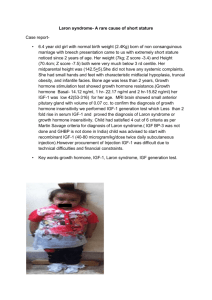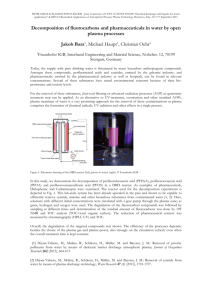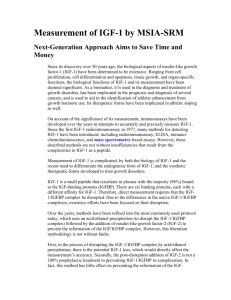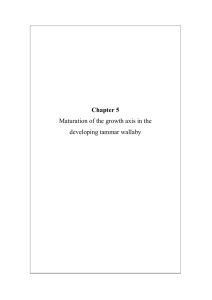Open Access version via Utrecht University Repository
advertisement
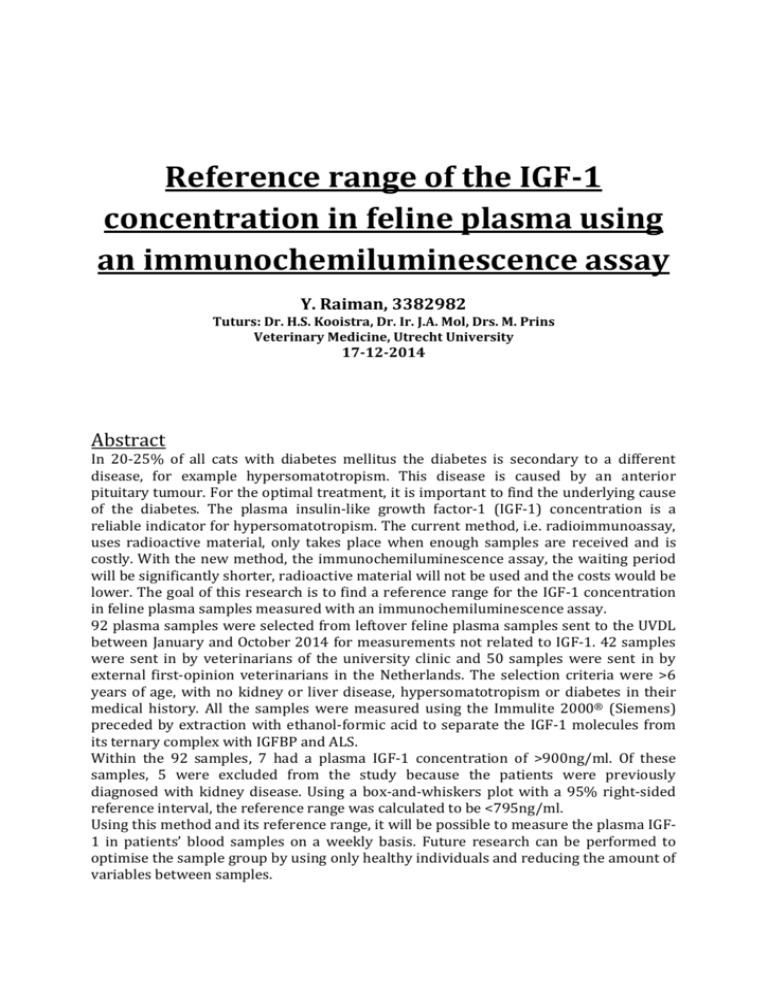
Reference range of the IGF-1 concentration in feline plasma using an immunochemiluminescence assay Y. Raiman, 3382982 Tuturs: Dr. H.S. Kooistra, Dr. Ir. J.A. Mol, Drs. M. Prins Veterinary Medicine, Utrecht University 17-12-2014 Abstract In 20-25% of all cats with diabetes mellitus the diabetes is secondary to a different disease, for example hypersomatotropism. This disease is caused by an anterior pituitary tumour. For the optimal treatment, it is important to find the underlying cause of the diabetes. The plasma insulin-like growth factor-1 (IGF-1) concentration is a reliable indicator for hypersomatotropism. The current method, i.e. radioimmunoassay, uses radioactive material, only takes place when enough samples are received and is costly. With the new method, the immunochemiluminescence assay, the waiting period will be significantly shorter, radioactive material will not be used and the costs would be lower. The goal of this research is to find a reference range for the IGF-1 concentration in feline plasma samples measured with an immunochemiluminescence assay. 92 plasma samples were selected from leftover feline plasma samples sent to the UVDL between January and October 2014 for measurements not related to IGF-1. 42 samples were sent in by veterinarians of the university clinic and 50 samples were sent in by external first-opinion veterinarians in the Netherlands. The selection criteria were >6 years of age, with no kidney or liver disease, hypersomatotropism or diabetes in their medical history. All the samples were measured using the Immulite 2000® (Siemens) preceded by extraction with ethanol-formic acid to separate the IGF-1 molecules from its ternary complex with IGFBP and ALS. Within the 92 samples, 7 had a plasma IGF-1 concentration of >900ng/ml. Of these samples, 5 were excluded from the study because the patients were previously diagnosed with kidney disease. Using a box-and-whiskers plot with a 95% right-sided reference interval, the reference range was calculated to be <795ng/ml. Using this method and its reference range, it will be possible to measure the plasma IGF1 in patients’ blood samples on a weekly basis. Future research can be performed to optimise the sample group by using only healthy individuals and reducing the amount of variables between samples. Introduction Diabetes mellitus (DM) is a common problem in cats. The majority of feline patients with DM has a type similar to diabetes mellitus type 2 in Rijnberk2010 humans. In approximately 2025% of cats the DM is secondary to a different endocrinological condition, e.g. hypersomatotropism or hypercortisolism, and is called type 3 diabetes mellitus. In these cats the veterinarian and owners find it difficult to regulate the diabetes and high dosages are often necessary. For these cats further diagnostic testing is indicated to search for a primary endocrinological disease. For future management of the disease it is vital to know whether an additional therapy for the primary disease could aid in the treatment of the patient. The focus of this research will be on hypersomatotropism as the underlying disease causing secondary DM and more importantly a new method of measuring will be discussed and its reference range will be determined. In cats hypersomatotropism is caused by a pituitary tumour Rosca2014 and is mostly seen in castrated, male cats of 6 to 15 years old.Rijnberk2010 This condition is characterised by hypersecretion of growth hormone (GH) by the anterior pituitary. GH excreted by the anterior pituitary has a direct and an indirect anabolic effect. Pierzchała2012 It promotes hepatic synthesis of insulin-like growth factor 1 (IGF-1).Gonzalez2014, Pierzchała2012 Excretion of IGF-1 from the body occurs through the urinary pathway.Nam1990 IGF1 mediates many functions of GH, for instance cell growth and proliferation.Sandhu2002 Symptoms in cats with hypersomatotropism are polyphagia, polyuria, polydipsia, weight gain, lameness, enlargement of the paws and facial features. Secondary to hypersomatotropism diabetes mellitus is generally present. For the diagnosis of hypersomatotropism either the plasma GH or the plasma IGF-1 is measured. Measuring GH has proven to be unreliable, as it is secreted in pulses.Reusch2006 For a reliable measurement of the GH concentration three to five blood samples are needed. The concentration of IGF-1 in the plasma is less subject to fluctuations. Therefore a single blood sample is sufficient for a reliable measurement of the IGF-1 plasma concentration. Follow up testing, after an outcome of IGF-1 plasma concentration higher than the reference range, is imaging of the pituitary using an MRI or CT scan.Roasca2013 In cats, as in many other mammals, most IGF-1 molecules in the plasma form a ternary complex with IGFBP3 (insulinlike growth factor binding protein 3) and ALS (acid-labile subunit).Lewitt2000 Most of the IGF-1, IGFBP3 and ALS are synthesised in the liver.Wu2010 This complex hinders IGF-1 from leaving the circulation to the tissues and therefore increases its halflife.Zapf1995,Lewitt2000 It is proven that a direct assay, i.e. without separating the complex made up of IGF1, IGFBP3 and ALS, results in falsely high concentrations of IGF-1. Tschuor2012 Previous research has shown that separation of this complex with ethanolformic acid extraction, thereby removing IGFBP3 and ALS from the sample prior to analysis, provides the most reliable measurements in feline plasma.Baxter1989, Blum 1994 RIA (radioimmunoassay) has been widely used for the measurement of IGF1. Tschuor2012,Berry2003,Castigliego2011 This method involves radioactive substances for which special measures need to be taken in the laboratory. For this reason RIA is not performed in the UVDL (University Veterinary Diagnostic Laboratory), but in a separate laboratory (located at the veterinary faculty in Utrecht, the Netherlands). In this laboratory RIA will only be performed when enough samples are received, resulting in a long waiting period for the results. The new method, based on an immunochemiluminescence assay using the Immulite® 2000 (Siemens) preceded by an extraction of IGF-1 from IGFBP and the ALS using ethanol-formic acid, will take place in UVDL on a weekly basis, making the waiting time for a result considerably shorter and the costs lower. The goal of this research is to find a reference range for the insulin-like growth factor-1 concentration in feline plasma samples measured by the Immulite® method preceded by an extraction with ethanol-formic acid. Material and method Samples In the period between January and October 2014 leftover feline plasma samples, containing more than 0.5ml of plasma, of cats >6 years old and sent to the university laboratory for any measurement, were evaluated. 92 samples were selected. 42 samples were sent in by veterinarians working at the university clinic and 50 samples by veterinarians from first opinion clinics in the Netherlands. The plasma samples were sent in for measurements not related to hypersomatotropism and diabetes mellitus. At the university laboratory these samples were stored at -20°C. Using the medical history of the university patients, a selection of suitable plasma samples was made. Patients known with diabetes mellitus, hypersomatotropism and liver and kidney problems were excluded. There was no medical history available of the external patients. From these samples a selection was made using the available information. After measurement of IGF1 external veterinarians were contacted for information about the medical history of their patients when a high plasma IGF-1 concentration (>900ng/ml IGF-1) was found. The generally used upper limit for IGF-1 is 1000ng/ml. Tschuor2012 Extraction and measuring method Extraction fluid: 87.5% EtOH/12.5% formic acid. Add to 11.6ml MilliQ, 938µl formic acid and add absolute EtOH to make the volume of the solution 100ml. Combine 100µl plasma with 400µl extraction fluid. Cover the tubes with parafilm and foil, vortex and leave for 30 minutes at room temperature. Centrifuge 30 minutes at 5000rpm and 4°C (pipet as soon as possible). This equals to a G-force of 5000g. For the measurements of the samples an Immulite® 2000 (Siemens) was used. This is a solid-phase, enzyme-labeled chemiluminescent immunometric assay. Only serum and heparin samples should be used in this assay, EDTA would affect the results. The required sample volume is 20µl. The IGF-1 bead pack contains 200 beads coated with murine monoclonal anti-IGF-1. The IGF-1 reagent wedge contains 6.5ml alkaline phosphate (bovine calf intestine) conjugated to polyclonal rabbit anti-IGF1 in buffer and 6.5ml IGF-2 in buffer.Instructions Immulite® Statistics The coefficient of skewness, the coefficient of kurtosis and the D'Agostino-Pearson test were used to determine whether the data had a normal distribution. A box-and-whisker plot was used to calculate the reference range. Additionally the confidence interval of the reference range was calculated. 3 Results Of the 7 samples from external veterinarians with an IGF-1 plasma concentration of >900ng/ml, 5 were said to have a kidney problem in their medical history and for this reason these samples were excluded from this research. 0 200 400 Statistically the data set does not have a normal distribution. The coefficient of skewness, the coefficient of kurtosis and the D'Agostino-Pearson test for normal distribution reject a normal distribution. Using a box-and-whiskers plot (see figure 1) with a right-sided reference interval of 95%, the upper limit of the reference range of the IGF-1 plasma concentration is calculated to be 795ng/ml. This limit lies within a 90% confidence interval from 645 to 1090ng/ml (see figure 2). 600 800 IGF-I (ng/ml) 1000 1200 Figure 1. Box-and-Whiskers plot 4 1200 1000 800 600 Methods Percentile 400 200 0 Figure 2. Confidence interval Discussion The plasma samples used in this study are all leftover from plasma sent in by veterinarian for an array of reasons. One can assume that most samples were sent in because the cats were showing symptoms of some kind. For this reason these samples might not be an ideal representation of the healthy Dutch cat population. Ideally only healthy individuals are used for determining a reference range. and were therefore excluded from this study. We assume the other patients, that were included and that had a plasma IGF-1 concentration of less than 900ng/ml, were good representatives. Further research using only samples from the university clinics might be more reliable as one could see the full medical history. Ideally using healthy members of the cat population would be most suitable to determine a reference range. The medical history of most of the external patients was unknown. Of these patients only the ones with an unusually high IGF-1 plasma concentration were investigated further by contacting the veterinarian who sent the sample to the university laboratory. 7 samples from external patients were higher than 900ng/ml, 5 of these patients have kidney disease in their medical history The time between collecting the samples, centrifuging them and cooling them is unknown for every sample as each sample was sent in by either university veterinarians or first opinion veterinarians without a specific protocol. The time between collecting the blood and arriving at the university laboratory is also unknown. As is the temperature in which the samples were 5 stored and sent. The vein from which the samples were taken is also unknown. These variable might have an effect on the IGF-1 concentrations in the plasma samples. Further research might shed light on the matter. When determining a reference range individuals of a similar age group to that specific disease should be used, in this case patients with hypersomatotropism are adult cats. For this reason samples of young cats were excluded from this study. It is said that young animals have a higher plasma IGF-1 concentration than adult animals.Juul1995 More research can be done to further simplify the extraction method to make the process even more user friendly. Preliminary research has shown that shortening the centrifuge time from 30 minutes down to 5 minutes and changing the temperature during centrifuging from 4°C to 20°C results in similar measurements of the IGF-1 plasma concentration. Kidney problems seem to have a strong effect on plasma IGF-1 concentration in cats. Of the 7 cats with a plasma IGF-1 concentration of >900ng/ml, 5 were known to have a kidney problem. More research can be done to explore the relation between kidney problems and IGF-1 plasma concentrations. A normal distribution of the data set was rejected using several tests. The reason for the absence of normal distribution can be explained by examining the boxand-whiskers plot. 23 of the total of 92 samples had a plasma IGF-1 concentration of <25ng/ml. Within this study the reason for this low outcome is unknown. Further research might explain the reason for this skewed distribution. Conclusion With the plasma samples used in this study a reference range was calculated within a confidence interval. The reference range is <795ng/ml within the 90% confidence interval 6451090ng/ml. There are several issues that need to be addressed in future research. For following studies the advice is to use a group of healthy cats that form a good representation of the disease population, for example keeping age as a criterion for inclusion. A reference range, made using these individuals, would be more reliable for comparison to patients with diabetes mellitus that might have primary hypersomatotropism caused by a tumour in the anterior pituitary. Using a protocol for collection of the blood samples and centrifuging and storing of the plasma samples will decrease the amount of variables between the samples. This study is the first step in providing an insight in the reference range for plasma IGF-1 using an immunochemiluminescence assay. In the future this method could replace the currently used method i.e. RIA. 6 References 1. Baxter RC, Martin SJL, Beniac VA. High molecular weight insulin-like growth factor binding protein complex. purification and properties of the acid-labile subunit from human serum. The journal of biological chemistry; 1989. Vol. 264, No. 20, Issue of July 15, pp. 11843-11848. 2. Berry SDK, Howard RD, Jobst PM, Jiang H and Akers RM. Interactions between the ovary and the local IGF-I axis modulate mammary development in prepubertal heifers. Journal of Endocrinology; 2003. 177, 295–304 3. Blum WF, Breier BH. Radioimmunoassays for IGFs and IGFBPs. Growth Regul 1994; 4(suppl 1):11–19. 4. Castigliego L, Li X, Armani A, Mazzi M, Guidi A. An immunoenzymatic assay to measure insulin-like growth factor 1 (IGF-1) in buffalo milk with an IGF binding protein blocking pre-treatment of the sample. International Dairy Journal 21; 2011. 421-426. 5. Gonzalez-Valero L, Rodriguez-Lopez JM, Lachica M, Fernandez-Figares I. Metabolic differences in hepatocytes of obese and lean pigs. Animal; 2014. 8(11):1873-1880. 6. Instructions Immulite® 2000 systems, Siemens. 7. Juul A, Dalgaard P, Blum WF, Bang P, Hall K, Michaelsen KF, Müller J, Skakkebaek NE. Serum levels of insulin-like growth factor (IGF)-binding protein-3 (IGFBP-3) in healthy infants, children, and adolescents: the relation to IGF-I, IGF-II, IGFBP-1, IGFBP-2, age, sex, body mass index, and pubertal maturation. J Clin Endocrinol Metab. 1995 Aug;80(8):2534-42. 8. Lewitt MS, Hazel SJ, Church DB, Watson AD, Powell SE, Tan K. Regulation of insulin-like growth factor-binding protein-3 ternary complex in feline diabetes mellitus. J Endocrinol; 2000 Jul;166(1):21-7. 9. Nam TJ, Noguchi T, Funabiki R, Kato H, Miura Y, Naito H. Correlation between the urinary excretion of acid-soluble peptides, fractional synthesis rate of whole body proteins, and plasma immunoreactive insulin-like growth factor-1/somatomedin C concentration in the rat. British Journal of Nutrition; 1990. 63(3):515-520. 10. Pierzchała M, Pareek CS, Urban´ski P, Goluch D, Kamyczek M, Ro´zycki M, Smoczynski R, Horban´czuk JO, Kurył J. Study of the differential transcription in liver of growth hormone receptor (GHR), insulin-like growth factors (IGF1, IGF2) and insulin-like growth factor receptor (IGF1R) genes at different postnatal developmental ages in pig breeds. Mol Biol Rep; 2012. 39:3055–3066. 11. Reusch CE, Kley S, Casella M, Nelson RW, Mol J, Zapf J. Measurements of growth hormone and insulin-like growth factor 1 in cats with diabetes mellitus. Veterinary Record 2006; 158, 195-200. 7 12. Rijnberk A, Kooistra HS, eds. Clinical Endocrinology of Dogs and Cats, 2nd edition. Schlütersche Verlagsgesellschaft mbH & Co. 2010;. Chapter 2 Hypothalamus-Pituitary System p. 25-27, Meij BP, Kooistra HS, Rijnberk A. 13. Rijnberk A, Kooistra HS, eds. Clinical Endocrinology of Dogs and Cats, 2nd edition. Schlütersche Verlagsgesellschaft mbH & Co. 2010;. Chapter 5 Endocrine Pancreas, p. 159-172, Reusch CE, Robben JH, Kooistra HS. 14. Rosca M, Forcada Y, Solcan G, Church DB, Niessen SJM. Screening diabetic cats for hypersomatotropism: performance of an enzyme-linked immunosorbent assay for insulin-like growth factor 1. Journal of Feline Medicine and Surgery; 2014. 16(2):82-88. 15. Sandhu MS, Dunger DB, Giovannucci EL. Insulin, Insulin-Like Growth Factor-I (IGF-I), IGF Binding Proteins, Their Biologic Interactions, and Colorectal Cancer. J Natl Cancer Inst 2002; 94 (13): 972-980. 16. Tschuor F, Zini E, Schellenberg S, Wenger M, Boretti FS, Reusch CE. Evaluation of four methods used to measure plasma insulin-like growth factor 1 concentrations in healthy cats and cats with diabetes mellitus or other diseases. American Journal of Veterinary Research 2012; 73(12):1925-1931. 17. Zapf J, Hauri C, Futo E, Hussain M, Rutishauser J, Maack CA, Froesch ER. Intravenously Injected Insulin-like Growth Factor (IGF) I/IGF Binding Protein-3 Complex Exerts. J Clin Invest. 1995 Jan; 95(1):179-86. 8
